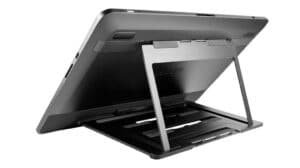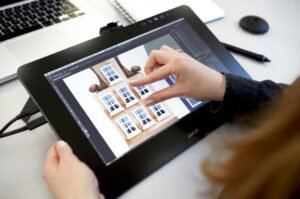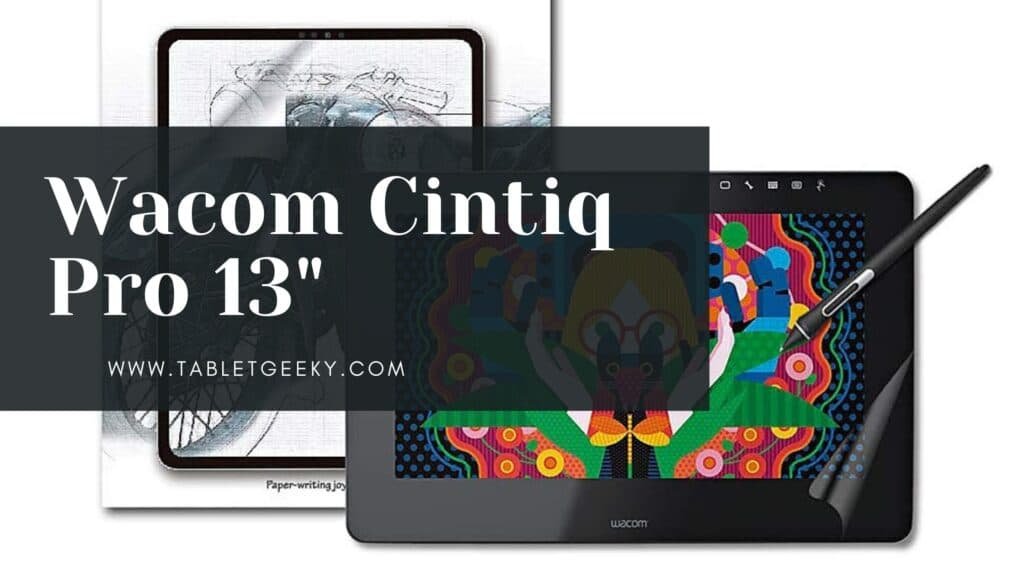If you’re seeking a tool to increase fecundity, speed, and efficiency with post-processing, there is nothing that will give more of all of those than a great pen tablet; something like the Wacom Intuos Pro, with its pen & touch functionality, a radial dial, absence of lag, and eight express keys.
Sure, things like Loupedeck (poor) and Palette (surprisingly good), and Pfizer exist, but they are no replacements for a great pen tablet. But there’s another alternative: a pen tablet and then some: Pen Displays, like the Wacom Cintiq Pro.
Table of Contents
Specifications:-
| Hardware Specifications of Wacom Intuos Pro 13 | |
| Pen sensitivity | 8192+ Levels |
| Active Area | 11.6 x 6.5″ – 1920 x 1080 |
| Input Resolution | 5080 LPI |
| Pen | EMR |
| OS Support | MAC OS 10.12 or later and Windows 7 or later |
| Input | 100 to 240 VAC, 50 / 60 Hz |
| Weight | 2.4 lbs |
- Professional quality.
- Value for money.
- Affordable price.
- Some user don’t like to work on 13 inch display.
Performance
The 16-inch Wacom Cintiq Pro has a remarkable 4K display. Its IPS display is color accurate, with excellent contrast levels, and the pixel density is such that you don’t ever feel you’re operating with a screen.
This is in part due to the density of the screen between surface and pixels, which is least on both models.

There are very few parallaxes – that odd artifact where, in early models, you can see between the nib and the original image. This, and the wonderfully matte etched glass, makes for a more natural-feeling knowledge.
Often a firm nib and glass won’t have quite the correct amount of friction, but the Cintiq Pros both are a joy to work with, be it for sculpting 3D models in ZBrush or paying time doing concept jobs in Corel Painter or Adobe Photoshop.
Accessories
Much was said about previous Cintiq stands, little of it ample, and Wacom has received. These two models have solid fold-out legs that do a fabulous job of holding the tablet, even when you’re leaning massively on the screen.

They aren’t flexible, so sadly, you will need to mix up into a convenient working position, but they are set at a good 20 degrees so that they will satisfy most people. If you don’t like these legs, then there is a different platform that you can purchase that gives more usability.
These have softkeys top-right to access particular functions such as frames, keyboard, and touch input like previous models. This is excellent and keeps the elegantly minimal device seeing sleek, but few express keys would be important for those who shove the keyboard to one side to get the most convenient access to draw.
Pro Pen 2
The display can be as brief as you like, but if the stylus is no excellent, it will always be left to one side, given the heap of tech, so many of us have. Fortunately, the Pro Pen 2 comes in the box – it is unique, following the same layout as previous models, with a button at each end (nib and eraser) and a two-button rocker.
The soft-touch rubber is easy and chunky enough to reduce strain on the hand for continued usage. This version has the tilt from previous substances, but the sensitivity has been extended to over 8000 levels. While this may sound overkill, it performs a lot of sense in use, as the more delicate, the more like old media it feels.
Pen, Pen Functionality & Pressure Sensitivity
The Wacom Cintiq Pro and MobileStudio Pro both use the latest Intuos Pro Pen 2, though they can be done with Wacom’s 3D pen. The pen has a fabulous ergonomic form that feels light in hand and has two programable buttons on the pen shaft and the standard eraser on the back.
It’s very active and provides for ease of use when doing detailed work. The Cintiq Pro and the Pro Pen 2 work collectively using EMR technology (Electromagnetic Resonance), which involves the current digitizer’s display, and the pen is affected.
This is a great thing, despite some people recommending AES is better, because, with EMR, the pen doesn’t require to be charged, is lighter, less costly to replace, and unlike AES systems, there is no obstacle in inputs, so it feels urgent and natural.
EMR jitter is also not a difficulty with this sequence for the first time. Some have demanded to see it, but in my practice, it has not reared its head.
Connectivity
Wacom has taken a leaf out of Apple’s book and allowed USB-C, which is excellent, and the Cintiq Pro 13 has 3 USB-C ports. And like
The difficulty, however, is that you cannot power and give data to the Wacom Cintiq Pro 13 using a single cable, which suggests you’ll have two cables secured into the unit at all times: one for power and one for data.

This gets away a bit from the clean, beautiful, and if you’re a cable-management fiend, this can be not very pleasant. Still, it’s not almost just to be a deal-breaker.
And if you are still working on an older computer without USB-C (like me most of the time), Wacom has introduced the Wacom Link and required cables to join. This is not a problem for the Cintiq Pro 13 as it can be for users of the higher models, which are 4K.
The cable produced by Wacom for the 16-inch version is a MiniDisplay cable that isn’t 4K available, so you have to purchase a cable of that spec to use an earlier machine and still use 4K.
Multi-touch
Something else to think about is the multi-touch ability of whatever tablet you want. Some avoid it, some like it, and Wacom’s multi-touch works great and better with each generation. Palm denial has come so far as to be a complete non-issue, and for those utilized to using Apple’s trackpad, the tablet can take its position in many ways. Because remember, the Cintiq Pro can be put into standard pen tablet form, which effectively turns your Cintiq into an Intuos Pro.

That said, the only constant issue I have found with the Cintiq Pro is that the touch ability, while ideal when it works, does give some trouble changing from your main monitor to the Cintiq.
So, for instance, when the Cintiq is in use and not mirroring (so acting as the main display) regarding the screen can make it work as a trackpad for your other monitor, suggesting you can use the touch ability to travel the other screen but not the Cintiq. I’ve found the only way around this is to toggle the screen mode in tablet and display and use a bit of a forceful touch. Surely, this can be fixed with firmware.
Conclusion
This all continues to show that, even when it seems like a developer has created success, there is constantly room for improvement.
Both these Wacom Cintiq Pros are unbelievable machines that will aid designers and artists in a way that is effective, convenient, and in some cases inspiring. The experience is excellent and, while the price is higher than other alternatives, the investment is a one-time cost that’s well worth performing.
The 13-inch model may not give quite the same impact as the bigger sibling, but it’s substantially more affordable. It can be put into a bag with a laptop for running in a more portable fashion – making it ideal for location work or simply getting out of the home to work over a coffee.
Practicing the Intuos Pro, I have hotkeys and my keyboard; I have it planned to a small fraction of the active area so I can move the cursor across the entire screen with the flick of a wrist. At the day’s finish, I am constantly looking straight ahead and a little up at my big monitor. And that gives the Cintiq Pro, for me, a niche good that I admire to use on occasion, but not a workhorse.
Ben Scott is a prominent technology journalist and reviewer, specializing in tablet devices. He is known for his comprehensive and unbiased reviews of tablets from various manufacturers.
With a deep understanding of tablet technology, including hardware components, operating systems, and software applications, Scott provides clear and informative reviews accessible to readers of all levels of technical expertise.
His attention to detail and in-depth analysis have earned him a loyal following of readers.


